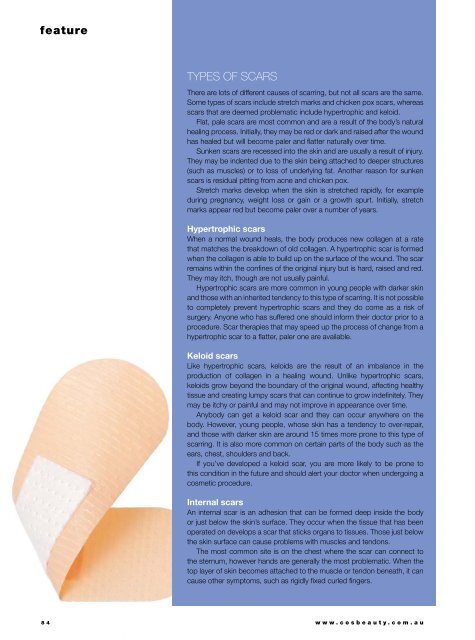Cosmetic Surgery and Beauty Magazine #68
You also want an ePaper? Increase the reach of your titles
YUMPU automatically turns print PDFs into web optimized ePapers that Google loves.
feature<br />
Types of scars<br />
There are lots of different causes of scarring, but not all scars are the same.<br />
Some types of scars include stretch marks <strong>and</strong> chicken pox scars, whereas<br />
scars that are deemed problematic include hypertrophic <strong>and</strong> keloid.<br />
Flat, pale scars are most common <strong>and</strong> are a result of the body’s natural<br />
healing process. Initially, they may be red or dark <strong>and</strong> raised after the wound<br />
has healed but will become paler <strong>and</strong> flatter naturally over time.<br />
Sunken scars are recessed into the skin <strong>and</strong> are usually a result of injury.<br />
They may be indented due to the skin being attached to deeper structures<br />
(such as muscles) or to loss of underlying fat. Another reason for sunken<br />
scars is residual pitting from acne <strong>and</strong> chicken pox.<br />
Stretch marks develop when the skin is stretched rapidly, for example<br />
during pregnancy, weight loss or gain or a growth spurt. Initially, stretch<br />
marks appear red but become paler over a number of years.<br />
Hypertrophic scars<br />
When a normal wound heals, the body produces new collagen at a rate<br />
that matches the breakdown of old collagen. A hypertrophic scar is formed<br />
when the collagen is able to build up on the surface of the wound. The scar<br />
remains within the confines of the original injury but is hard, raised <strong>and</strong> red.<br />
They may itch, though are not usually painful.<br />
Hypertrophic scars are more common in young people with darker skin<br />
<strong>and</strong> those with an inherited tendency to this type of scarring. It is not possible<br />
to completely prevent hypertrophic scars <strong>and</strong> they do come as a risk of<br />
surgery. Anyone who has suffered one should inform their doctor prior to a<br />
procedure. Scar therapies that may speed up the process of change from a<br />
hypertrophic scar to a flatter, paler one are available.<br />
Keloid scars<br />
Like hypertrophic scars, keloids are the result of an imbalance in the<br />
production of collagen in a healing wound. Unlike hypertrophic scars,<br />
keloids grow beyond the boundary of the original wound, affecting healthy<br />
tissue <strong>and</strong> creating lumpy scars that can continue to grow indefinitely. They<br />
may be itchy or painful <strong>and</strong> may not improve in appearance over time.<br />
Anybody can get a keloid scar <strong>and</strong> they can occur anywhere on the<br />
body. However, young people, whose skin has a tendency to over-repair,<br />
<strong>and</strong> those with darker skin are around 15 times more prone to this type of<br />
scarring. It is also more common on certain parts of the body such as the<br />
ears, chest, shoulders <strong>and</strong> back.<br />
If you’ve developed a keloid scar, you are more likely to be prone to<br />
this condition in the future <strong>and</strong> should alert your doctor when undergoing a<br />
cosmetic procedure.<br />
Internal scars<br />
An internal scar is an adhesion that can be formed deep inside the body<br />
or just below the skin’s surface. They occur when the tissue that has been<br />
operated on develops a scar that sticks organs to tissues. Those just below<br />
the skin surface can cause problems with muscles <strong>and</strong> tendons.<br />
The most common site is on the chest where the scar can connect to<br />
the sternum, however h<strong>and</strong>s are generally the most problematic. When the<br />
top layer of skin becomes attached to the muscle or tendon beneath, it can<br />
cause other symptoms, such as rigidly fixed curled fingers.<br />
84 www.cosbeauty.com.au


















